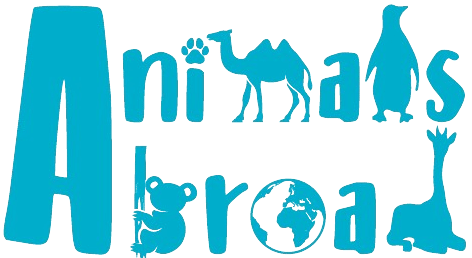Planning a self-drive, camping safari in Southern Africa is a serious adventure—and an unforgettable one, especially as a family. We spent 51 days camping across South Africa, Namibia, Zambia, andBotswana, encountering lions, leopards, elephants, and stunning landscapes along the way.
Whether you’re dreaming of a two-week adventure or something longer, this guide is for you. We’ve broken it down into practical advice, including route planning, renting a vehicle, choosing campsites, staying safe, and packing smart.
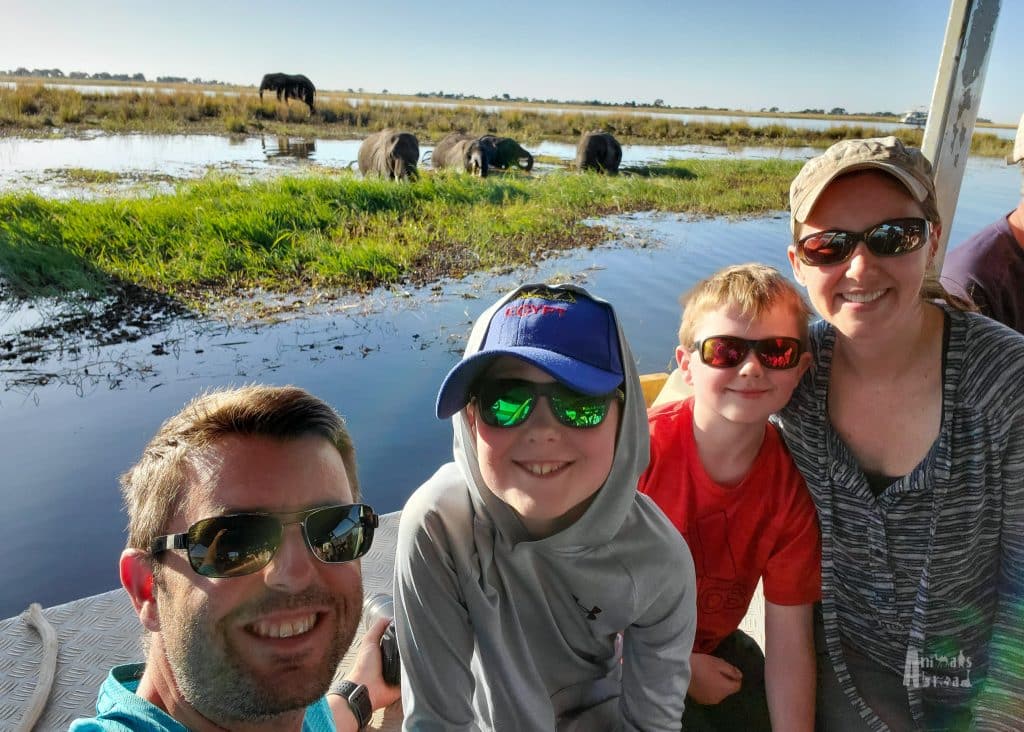
Planning
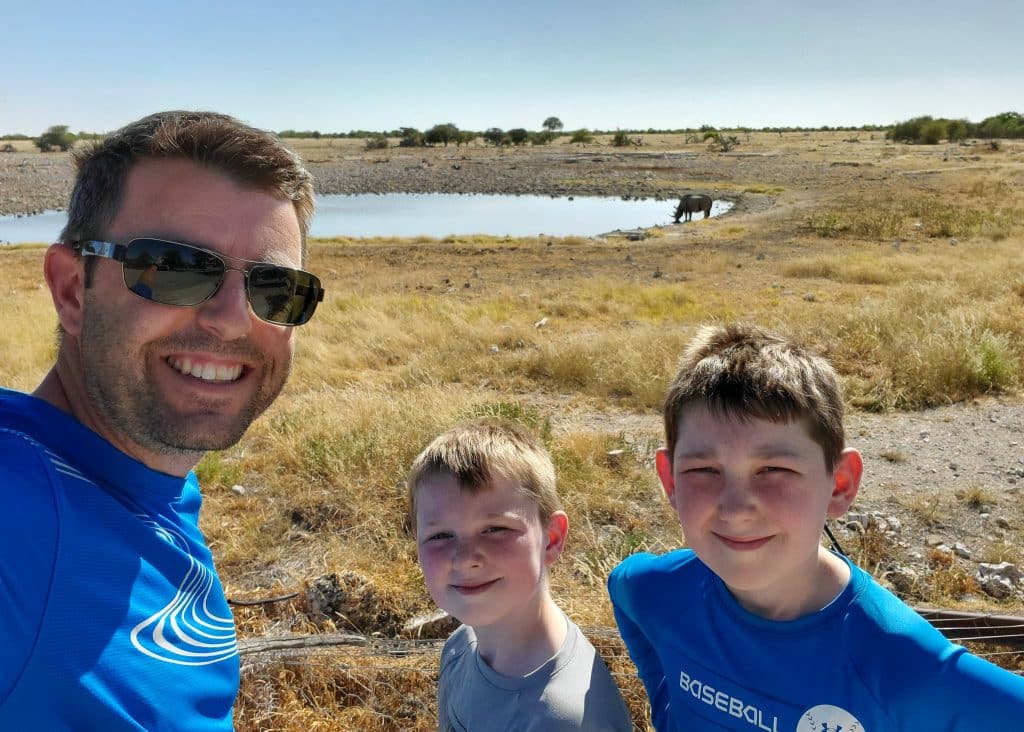
What was your itinerary?
Our 51-Day Camping Safari is easy to break down into smaller itineraries. Starting in Cape Town, we travelled up the coast of South Africa and Namibia, inland to Zambia and down through Botswana before finishing in Johannesburg.
- 51-Day Africa Safari – Part 1: South Africa & Namibia’s Coast
- 51-Day Africa Safari – Part 2: Namibia’s Etosha & Caprivi Strip
- 51-Day Africa Safari – Part 3: Victoria Falls & Botswana
Why did you choose to self-drive instead of joining a guided tour?
Our first safari was with an overland tour through Gap Adventures. It was a great introduction with knowledgeable guides, amazing wildlife, and comfortable camping. A tour is a fantastic way to go for first-timers or those unsure about driving off-road.
This time, however, we envisioned something more flexible: an extended self-drive camping trip across several countries and national parks. While we initially considered guided tours, the cost for four people quickly exceeded our budget. In fact, our 8-week self-driving safari costs about the same as a 2 week guided tour. And when you’re travelling with kids, a rigid group itinerary doesn’t always work well. We wanted to go at our own pace and linger where we wanted, so we designed our own adventure.
How did you decide which countries to include?
We’d previously been to Tanzania’s Serengeti and Ngorongoro Crater and wanted to explore new places. As animal lovers, wildlife was our top priority, but we also wanted variety in landscapes and experiences.
With so many incredible options, our itinerary started to take shape quickly. Here’s what made the final list:
• Namibia: for the incredible wildlife in Etosha and Caprivi Strip, and the unique landscapes of Sossusvlei and the Skeleton Coast.
• Botswana: for epic game viewing in Chobe and Moremi, plus the wild Nxai Pan and the Ancient Baobabs.
• Zambia: for the thundering beauty of Victoria Falls.
Tip: Be sure to review travel advisories before leaving. We skipped Zimbabwe due to travel advisories at the time, though seeing Victoria Falls from the Zimbabwe side was on our original wish list.
Does timing really matter?
Timing is everything. Our first safari happened during the rainy season, and we arrived in Livingstone, Zambia, to stormy skies and torrential rain. Our first night camping ended with all our belongings floating in a flooded tent. The rain didn’t stop, making the overland journey over mainly dirt roads, challenging at the best of times and dangerous at the worst. We knew we didn’t want to drive the treacherous roads and brave damp nights with kids, so we researched and planned our visit in the dry season.
Did you plan the entire route and book everything in advance?
We did. We rented our camper truck through South Africa 4×4, and they walked us through the planning process. We came to them with a detailed plan based on our research. Then we worked with the team at Africa 4×4, who gave helpful suggestions and helped us tailor the route. Once finalized, they booked the campsites and prepared a complete package with our itinerary, campground info, border documents, and all the directions we needed. When we picked up the truck, we were ready to hit the road!
Your Home on Wheels: Renting a Camper Truck
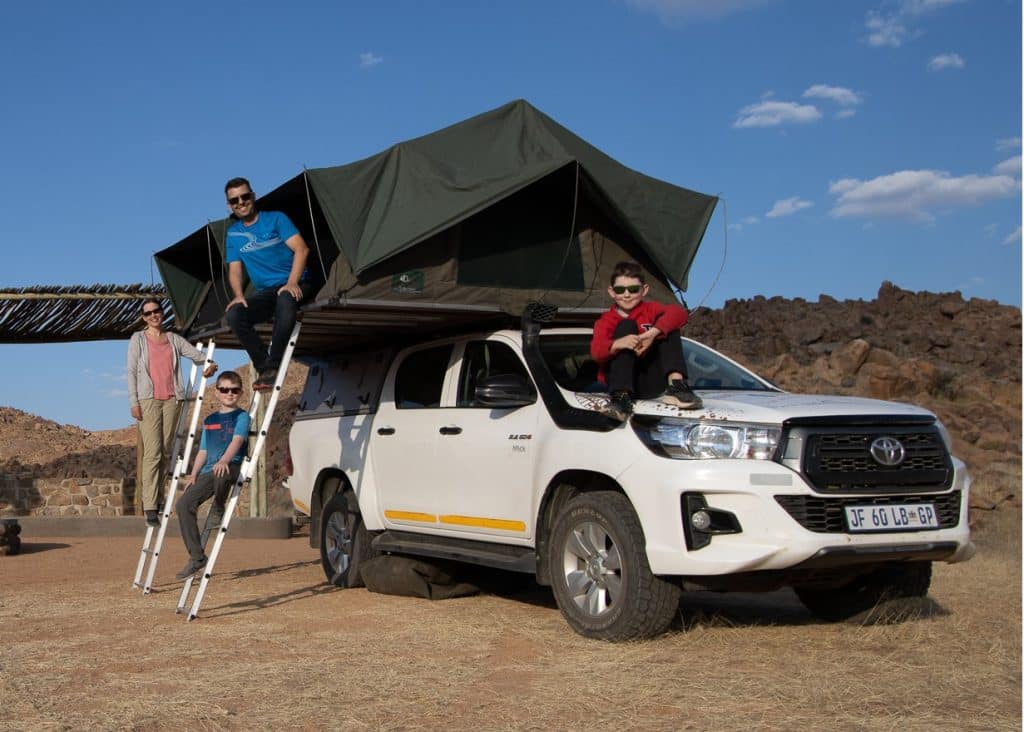
Who did you rent your camper truck from?
We rented our camper truck from Africa 4×4. We didn’t realize how popular self-driving safaris are until we started planning. There are many reputable rental companies with different vehicle options and planning support.
South Africa 4×4 stood out for a few key reasons:
• Flexible pick-up and drop-off: Many companies require round-trip routes starting and ending in the same city (usually Johannesburg). However, Africa 4×4 offers drop-off and pick-up in other cities in South Africa and Namibia, for an additional cost. We picked up our camper in Cape Town, which was perfect for our west coast route into Namibia.
• Affordability: After a lot of comparison, they were by far the cheapest for what we needed.
• Free itinerary support: They also offered complimentary assistance with planning and campsite bookings, saving us hours of work.
What was included in the camper truck?
The camper truck from South Africa 4×4 was equipped with everything we needed: cooking supplies, comfortable sleeping arrangements, and a sturdy build that felt safe even on the roughest roads. It had two pop-up tents for sleeping, storage for all our camping gear, and a fridge to keep food fresh, which was a big plus for the long drive ahead. It felt compact but incredibly well-organized. We were amazed how much gear fit neatly into the truck, and everything had its place.
What should I look for when choosing a camper truck?
Based on our experience, here are a few must-haves:
• Air compressor: Essential for adjusting tire pressure, especially for deep sand or rough terrain.
• Pop-up tents with mats, sleeping bags, and pillows included: Look for comfort and ease of setup.
• Fridge: A plug-in fridge with battery backup is a game-changer.
• Built-in GPS navigation.
• Satellite phone: There’s no cell service in remote parks.
• Propane stove: A reliable cooking option when fires aren’t allowed or wind is an issue.
• Water compartment: Useful for washing and cleaning, but not drinking.
• Camp chairs and table: They make all the difference.
• Rope and clothes pegs: For makeshift laundry and drying towels.
Did you need special insurance to rent the truck?
Yes. The rental company required additional insurance on the truck, but we opted for insurance through a third-party company, rather than the rental, as it was cheaper. We did have a claim (dented fender), and the submission/claims/payout process was easy, and the staff were professional.
We used Worldwide Insure, which cost about CAD 200 for our entire 17-month world trip and covered all our rentals. In contrast, rental companies charged on average CAD 15–30 per day for insurance. This simple hack saved us roughly CAD 2,000 over the trip. If you travel full-time or rent cars frequently, it’s a must. Keep in mind, our credit card insurance wasn’t an option since we didn’t return to our home country between destinations, so having independent coverage was essential.
What about an international driver’s license?
We didn’t need an international driver’s license for our camper van rental, but several other countries required it, and it was worth getting. Just keep in mind that it’s only valid for one year from the date of issue.
Was the truck hard to drive? Did you need any special training?
No special license or training is needed, but some off-road confidence helps. The truck is high-clearance and automatic, which makes it surprisingly easy to drive, even through sand and gravel tracks.
Still, a few skills came in handy:
• Basic vehicle maintenance: We had three flat tires and needed to change them ourselves, often in the middle of nowhere.
• Tire pressure adjustment: The compressor was essential for navigating soft sand. Ensure the rental team shows you how to use it before leaving.
Bottom line: You don’t need to be a mechanic, but you want to feel comfortable handling minor issues without roadside assistance nearby.
On the Road: Driving Tips & Road Conditions
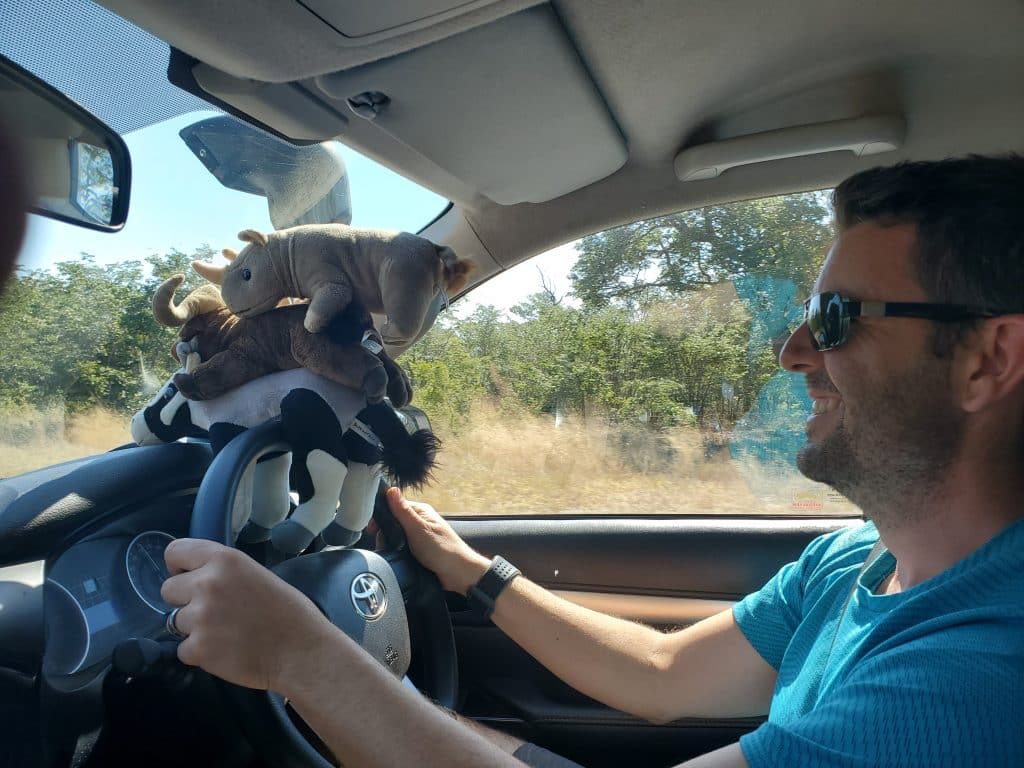
What side of the road do you drive on?
In Namibia, Zambia, and Botswana, cars drive on the left side of the road. But, since our truck was rented in South Africa, it was right-hand drive.
What are the road conditions like?
It varies a lot by country, region, and even day. Generally, the main roads (highways and cities) were easy to navigate. Roads within National Parks often consisted of rough terrain requiring 4×4 vehicles to navigate.
Here’s what we experienced:
South Africa had the best road network, with mostly paved roads and well-maintained highways.
Namibia’s roads, even the main ones, were often corrugated gravel. After long drives, we felt like our brains had been shaken loose!
In Zambia, the road between the border and Livingstone was a minefield—massive potholes, missing pavement, and at times, no actual road at all. Many vehicles drove along the shoulder to avoid the worst bits.
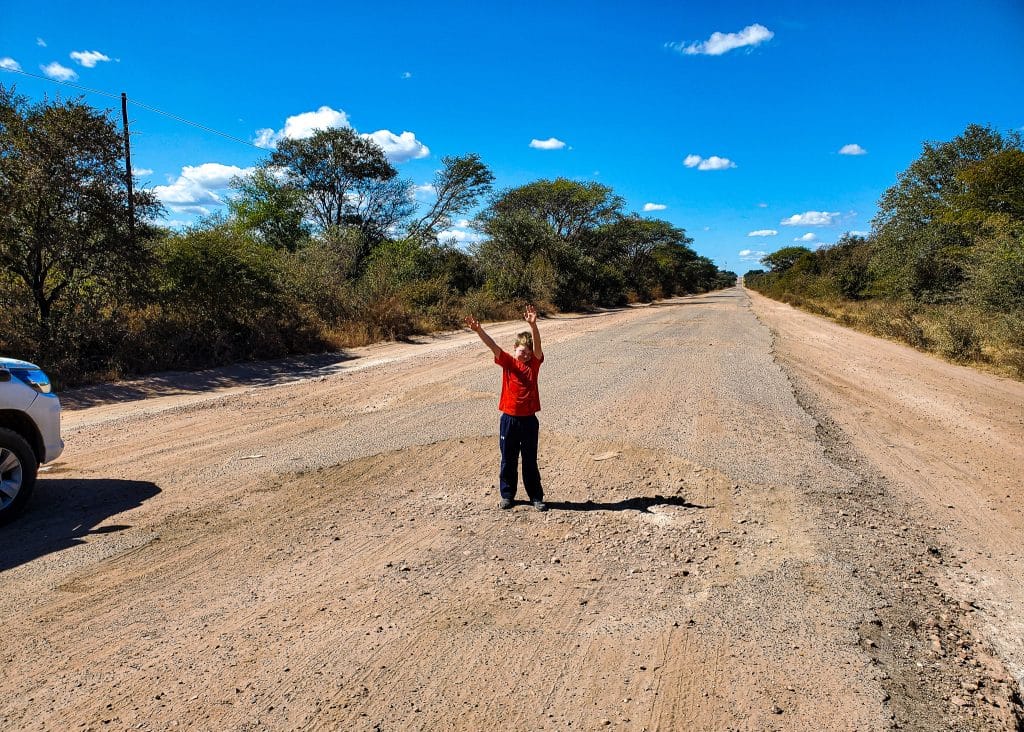
Once in the national parks of Botswana, it was even more rugged. Deep, soft sand, tight trails, and bumpy dirt tracks made for slow, bouncy progress. It was beautiful—but not for the faint of heart!

For more detailed road conditions, check out our 51-Day Africa Safari Itinerary.
How did you navigate?
Our camper came with a built-in GPS, and we used it daily. Each morning, we’d plug in our next destination and hit the road. It usually worked well, but we hit the occasional hiccup, like blocked roads or missing turnoffs, where we had to backtrack to a main road and find a new route manually. Having a paper map as backup would have helped us in a few situations.
How long did you drive each day?
It depended on where we were headed:
• Within national parks: 1–2 hours, usually slow-paced with lots of stops for wildlife.
• Between cities or camps: We aimed for 4 to 6 hours max per day. That gave us time to stop for snacks or bathroom breaks, and set up camp before dark.
Need Ideas on how to keep kids from going stir-crazy on long drives? Check out: Safari with Kids: Tips from the Road
What did you do for bathroom breaks?
Let’s just say we got comfortable with “wild bathrooms.” Long stretches of road often had no services at all. The boys were thrilled with the roadside option. It took me a little getting used to, but it became part of the adventure.
Is it safe to drive at night?
Absolutely not. Driving after dark is dangerous for several reasons:
• You can’t see potholes, puddles, or sandy patches that could leave you stuck or damage your truck.
• You don’t want to change a tire in the dark, especially in areas where wildlife—even predators—might be roaming nearby.
Safety Tip: Always plan to arrive at camp well before sundown. Road delays, GPS issues, or long border lines can slow you down. And many campsites (especially in Botswana) don’t have lights or fences. Setting up in the dark is no fun when there might be a leopard lurking in the bushes!
Did you encounter any speed traps or police blockades?
Yes, we encountered a few speed traps and roadblocks during our safari (both official and non-official).
In Namibia, we were pulled over by uniformed police in an official car equipped with radar, which showed our speed. They clearly indicated we were speeding and mentioned the fine amount. However, it was obvious they were expecting a cash payment. We paid a negotiated, lower amount in cash and were allowed to continue.
In contrast, while travelling through Botswana, we came across an unofficial roadblock set up by locals without uniforms or badges. They were enforcing a rule against carrying raw red meat into a protected area. Since we had stocked up on food for 4–5 days off-grid, we refused to hand over our supplies or pay any fine. After some back and forth, we told them we would cook the meat on-site but wouldn’t move the truck. Eventually, they let us pass with the raw meat intact.
Both experiences highlighted the importance of knowing local rules and standing firm when needed.
Border Crossings in Southern Africa
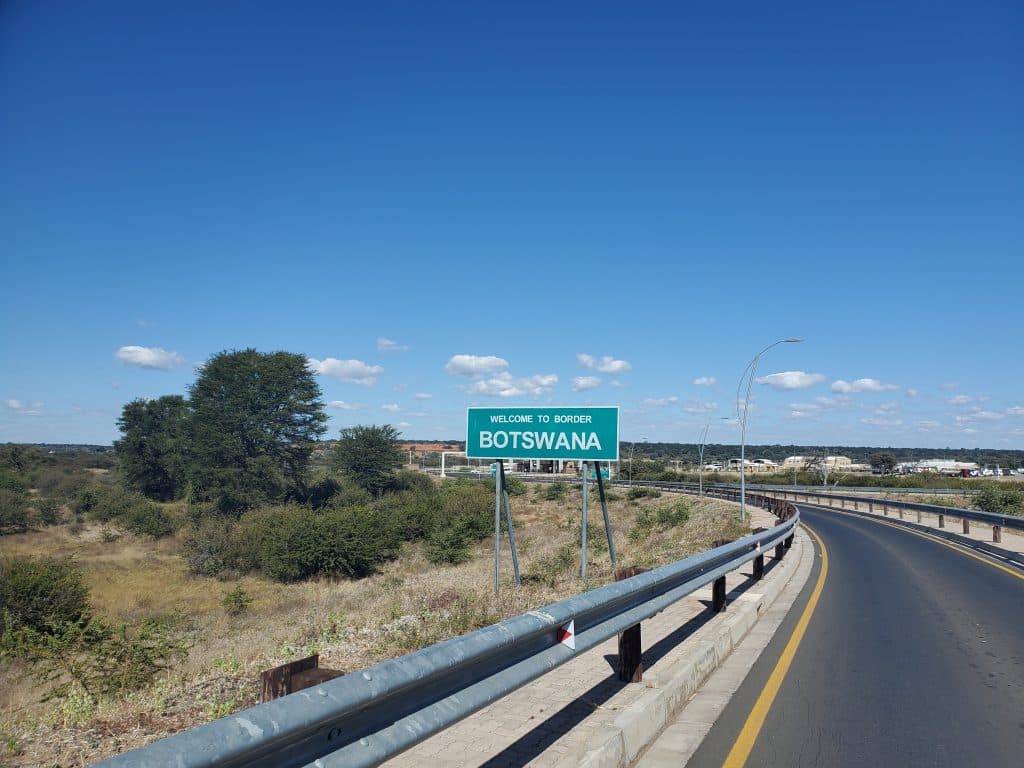
How long do border crossings take?
It depends—expect the unexpected. Border crossings in Southern Africa can be quick or painfully slow. Our longest wait was four hours, crossing from Namibia into Zambia. Most took about 1-2 hours, but it’s smart to:
• Arrive early in the day
• Be patient and polite
• Build extra time into your travel schedule
Tip: Always assume a border day will be your longest travel day.
Do you need visas?
Yes—visas are required for many nationalities when entering Namibia, Zambia, and Botswana. Requirements vary depending on your passport.
As Canadians, we could purchase visas on arrival at the border, but this isn’t the case for everyone. Some countries require:
• Applying in advance
• Proof of return tickets
• Travel itineraries or accommodation bookings
Tip: Check with official government websites or travel advisories for up-to-date visa requirements before you go.
What other documents should you have when crossing the border?
If you don’t have hard copies, be sure to download digital versions to your phone before you arrive at the border—connectivity is often limited. Here’s what you’ll need:
• Passports
• Birth certificates for minors (required in Botswana)
• Vehicle registration
• Letter of authorization from the rental company
• International Police Clearance (needed for Zambia)
All border crossings also required us to pay a road tax and/or insurance. Currency matters: bring both USD and local currency, as not all fees can be paid in either.
Costs, Fees & Money Matters
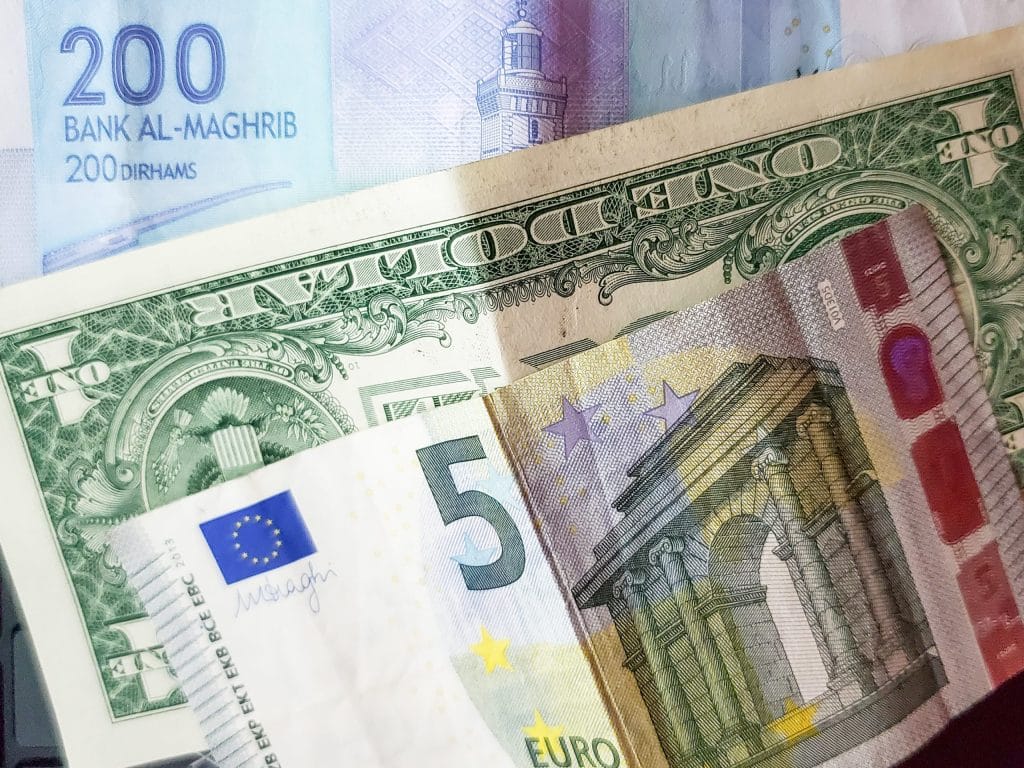
What was the cost of the camper truck and fuel?
We rented our camper truck for 51 days at a cost of approximately CAD 130 per day. Other expenses included:
• Mileage: Unlimited mileage was included in the rental. Our total mileage was 8419km.
• Fuel costs: Approximately CAD1600
• Extra charges for the satellite phone and drop off in Cape Town were included in the above rental fee.
Fuel prices varied by country and location, with remote areas typically charging slightly more. We filled up whenever possible, especially before heading into rural regions or national parks.
How do campground and park fees work?
Most campgrounds charged per person, and rates varied widely between countries. National Parks charged additional daily fees, typically per person, with an added vehicle fee as well. Here’s what we learned:
• Children under 8 were often free, and those under 16 were at a reduced rate.
• Some parks charge 24 hours from entry, while others use calendar days.
• If you camp inside a national park, you’ll pay both the campground and park entry fees.
Tip: Plan your days accordingly so that you do not incur additional costs.
Did you need cash, or could you use a credit card?
We prepaid for our truck rental and most campgrounds. Beyond that:
• Credit cards were accepted at gas stations, grocery stores, and most campgrounds.
• We used cash for:
– National park entry fees
– Firewood and small market items
– Campground restaurants or shops
– Guided tours
Was it easy to access cash?
Yes—in cities. But it wasn’t always straightforward.
• ATMS were available in larger towns, but some didn’t accept our cards.
• We learned which ATM brands worked best for us and always withdrew cash when we found one that did.
Tip: Use or exchange all your Botswana currency before leaving—Canadian banks won’t exchange it once you’re home.
What was the most expensive country you visited?
Botswana was by far the most expensive, especially compared to Namibia. The people of Botswana value their resources and want to preserve them for years to come. The higher prices limit the number of tourists, decreasing the impact of human-wildlife contact and preventing crowds from destroying the habitats.
Campgrounds, National Parks, and guided tours were all more expensive. Despite the cost, Botswana was absolutely worth it, becoming our favourite stop on our safari. From the Okavango Delta to Chobe National Park and the Makgadikgadi Salt Pans, it offered some of our trip’s most raw and intimate wildlife encounters.
What was the overall cost of your 51-day self-driving safari?
The total cost for our 51-day safari was CAD 18,972.
Health & Safety
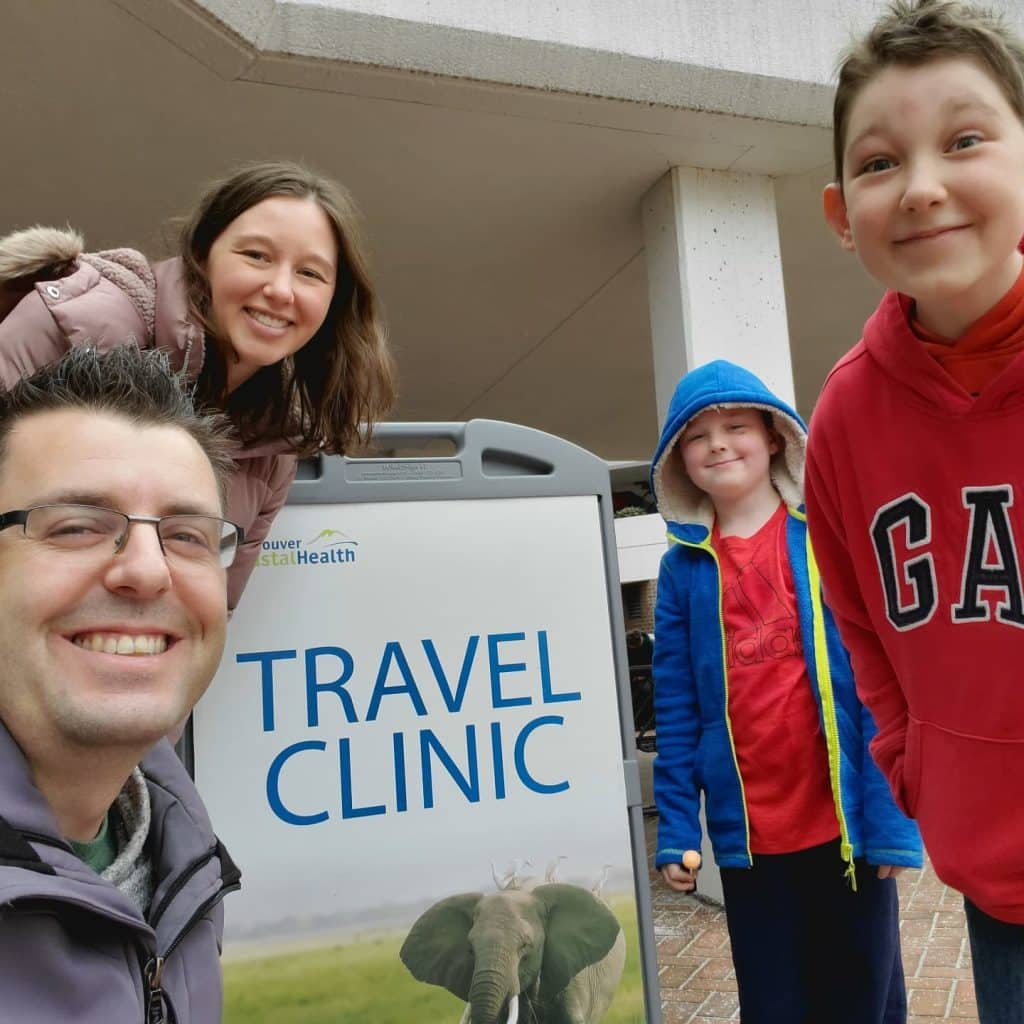
What kind of health insurance did you use?
We used Safety Wing for our world trip’s health coverage. While it offered good basic coverage and flexibility, we were unable to collect on any claims we submitted. Some expected expenses were not covered, so we recommend researching thoroughly to find the best option for your needs, especially for long-term travel.
Did you need any vaccinations for your safari?
Yes. The travel clinic we visited recommended keeping all routine vaccinations up to date (like tetanus), and also advised the following travel-specific vaccines:
• Hepatitis A
• Typhoid
• Rabies
• Yellow Fever
A Yellow Fever vaccination certificate was required for entry into Zambia. South Africa, Namibia, and Botswana also require a Yellow Fever certificate if you arrive from a country considered at risk for Yellow Fever transmission (such as Zambia).
The clinic also prescribed an oral antibiotic we filled before leaving, in case of gastrointestinal infections (vomiting or diarrhea).
Did you have to take malaria pills the whole time?
No, we didn’t take malaria pills every day of the trip. The travel clinic outlined the higher-risk malaria areas within each country, and we followed their guidance based on our route. After reviewing the options, we chose Malarone, which is known for having fewer side effects.
Always consult your primary care provider or a travel clinic before departure. Recommendations can change, and it’s important to make sure your whole family is protected and prepared.
What did you do about drinking water?
Cape Town was the only stop on our route with safe drinking water. We either used bottled water or filtered tap water ourselves.
We brought LifeStraw water bottles, which were fantastic for filtering bacteria and parasites. With LifeStraw bottles, we could drink from any fresh water source. This saved us tons of space, as we didn’t have to stock up on bottled water constantly. When heading to remote campsites without a fresh water source, we bought large jugs of purified water for cooking and drinking.
When campsite water was available, we used it for cooking, but boiled it first.
What should go in your medical kit?
We knew we’d be off-grid for stretches, so we packed a thorough travel first-aid kit that included:
• Medications: Pain/fever relief (Advil, Tylenol), anti-nausea (Gravol), anti-diarrhea (Imodium), antihistamines (Benadryl), cold medication, throat lozenges, eye drops.
• First aid supplies: Band-Aids (various sizes), antiseptic cream (Polysporin), alcohol wipes, saline, Flammazine (burn cream), small scissors, tweezers, gauze, instant ice pack.
• Outdoor protection: Sunscreen, insect repellent, anti-itch (Benadryl stick).
• Thermometer
We used Care Plus Insect Repellent for the kids, which contains 20% Icaridin instead of DEET. Here’s the one we used.
Did you experience any injuries or illnesses while on safari?
Luckily, we all remained healthy during our safari, except for a mild case of COVID. We isolated at a private campsite and followed the public health recommendations at the time.
Communication
What was the internet access like?
We used a portable hotspot for internet access while travelling between locations, then connected to campground Wi-Fi when available. SIM cards are an option, but we found the hotspot more convenient since it saved us from hunting down phone stores in each country.
Even in some more remote camping areas, we could send WhatsApp messages and check emails. We usually had to wait for video calls with friends and family until we were at a campground closer to a town or city with stronger Wi-Fi.
What about emergencies on the road?
We rented a satellite phone from our camper truck rental company for peace of mind in case of emergencies. It was meant to provide reliable communication, even in the most remote areas without cell coverage. Unfortunately, that wasn’t our experience. On two occasions when we needed assistance, the phone failed to connect.
Camping
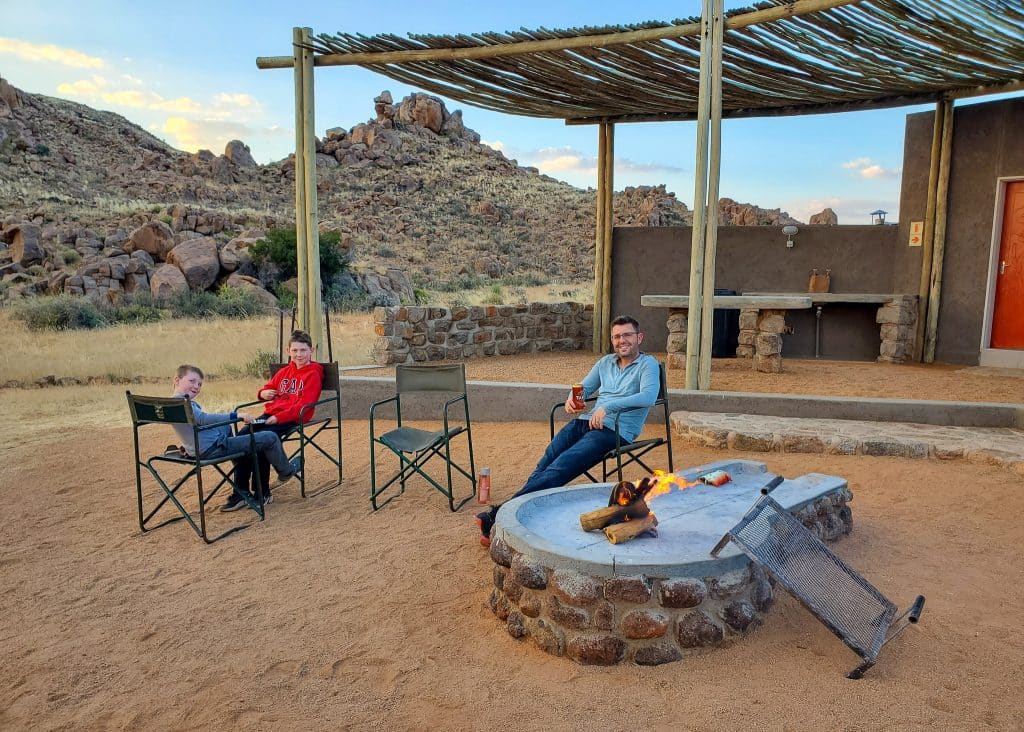
What were the amenities like at the campgrounds?
Throughout our camping journey, we experienced a wide range of campsites—from well-equipped resorts to remote, peaceful hideaways. Most campgrounds offered either private or shared ablution facilities, with showers, and on-site power and water. Wi-Fi was usually available in the reception area.
Namibia has an extensive network of campgrounds called Namibia Wildlife Resorts (NWR). These were generally easy to access and provided amenities like showers, restaurants, cabins, and laundry services. However, they also came with higher prices and larger crowds. In contrast, Botswana’s campgrounds were more rural and tranquil, often tucked deep into the wilderness areas of national parks.
Learn More: Camping Across Southern Africa: A Rundown of our Safari Campsites
Are there animals in the campground?
Yes—expect to share your space with some very wild neighbours, especially in Botswana, where national parks are unfenced and animals are free to wander through.
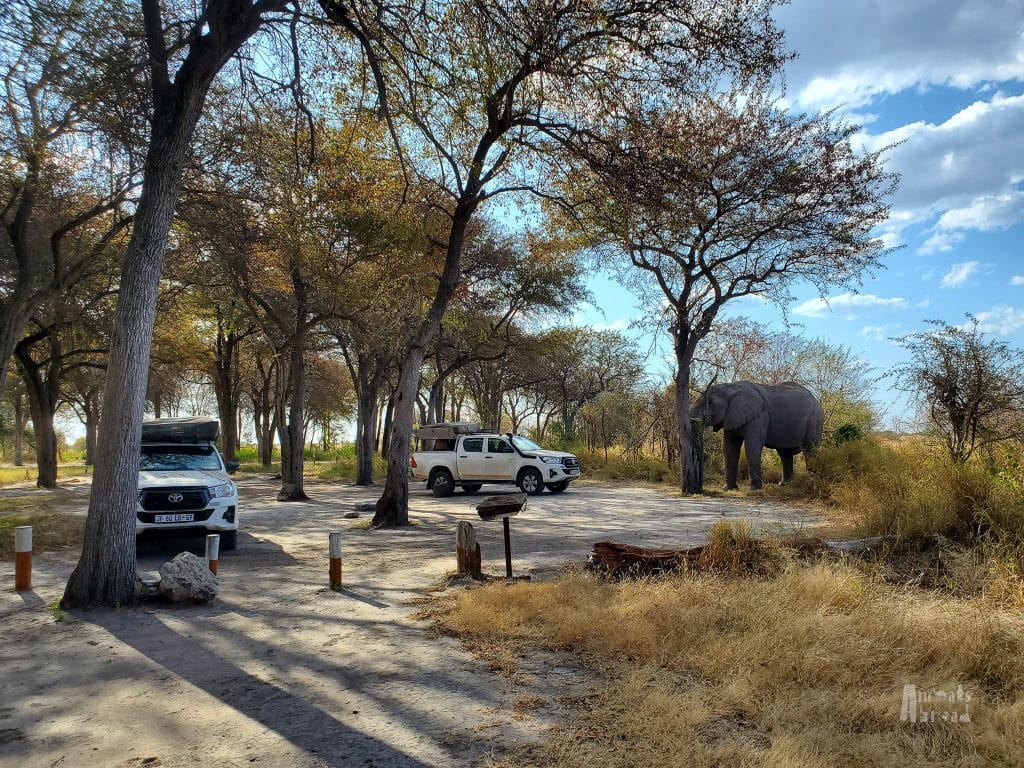
Here are some of our most memorable campground visitors:
Baboons: These bold troublemakers were frequent visitors. They’re not afraid of humans and will steal food; in some areas, they tear apart unattended tents. It’s best not to leave anything out, even for a moment.
Elephants: It wasn’t unusual to have elephants wander through our campsite, especially in Linyanti (Chobe National Park) and near South Gate in Nxai Pan. If you stay calm and keep your distance, these gentle giants might reward you with an up-close encounter. Pull up a chair and enjoy
Hippos: We stayed alert for hippos whenever we camped near a river, like in the Caprivi Strip and along the Chobe River. They tend to move through camp to graze from dusk to dawn. Hippos are incredibly territorial and are responsible for more human deaths in Africa than any other animal. Never, ever get between a hippo and the water.
Predators: Botswana campground managers warned us about large predators, including lions and leopards, that roam at night. We often heard lions roaring in the distance and had a couple of close encounters. One night, we startled a hyena near our truck as we were getting ready for bed. Another time, we caught sight of a crouching leopard on our way to the bathroom. It was a powerful reminder: we were guests in their territory.
Groceries & Meals
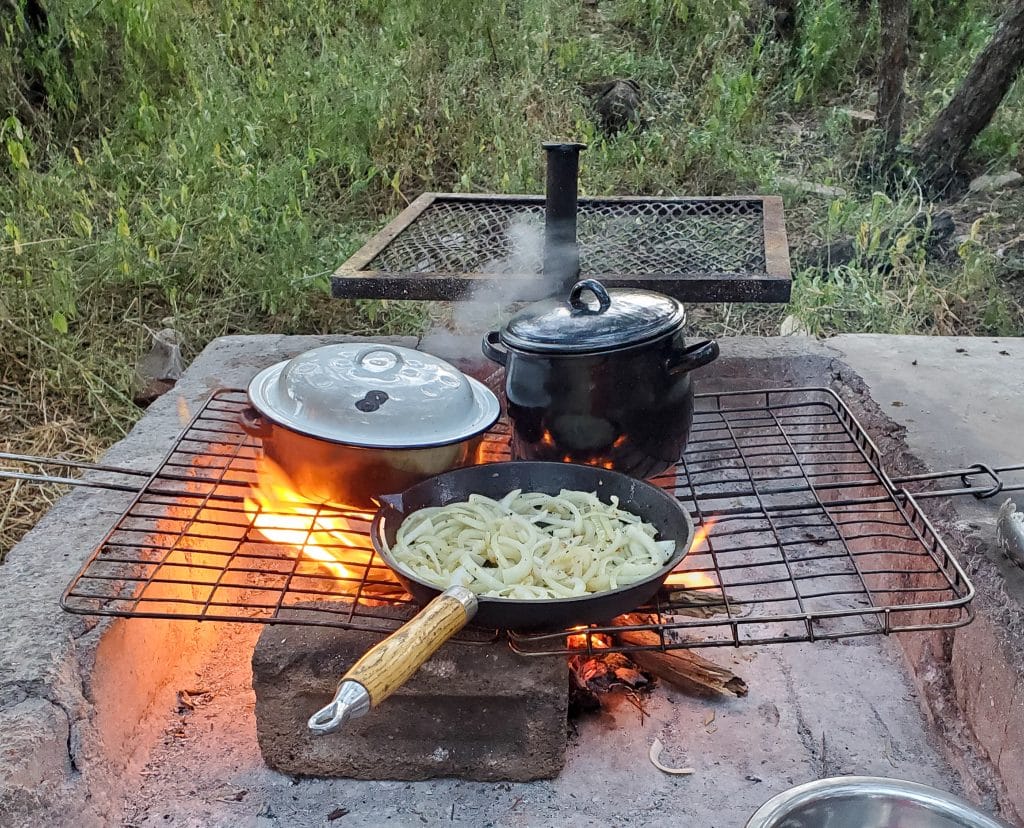
Was it easy to find grocery stores?
Grocery stores and gas stations were easy to find in larger towns and cities. We often passed one on the way to our next stop, but occasionally had to make a short detour to restock. National Parks do not have any food provisions, so it’s important to plan ahead and stock up before you head into remote areas.
We used our GPS system to locate the nearest grocery stores. In Namibia, look for Shoprite, Spar, and OK Foods—they were reliable and well-stocked.
What did you make for dinner?
We ate well on safari! Beef is inexpensive in Namibia, so we enjoyed a lot of steak dinners, curries, and pasta dishes. For breakfast, we usually had cereal or toast and eggs.
Kid-friendly snacks like granola bars, yogurt, fruit, chips, and crackers were easy to find in the larger stores. We also brought a few creature comforts from home, including Kraft Dinner, hot chocolate, marshmallows, and peanut butter—though we found some locally too!
Tip: Eat a big breakfast when possible—stopping for lunch on the side of the road isn’t always easy.
How did you cook?
Our camper truck came with a single propane burner, but we quickly learned that propane was difficult to replace along our route. We cooked almost all our meals over a campfire and saved the propane burner for backup, especially on windy nights when a fire wasn’t possible.
We’d occasionally grab dinner at a campground restaurant as a treat—pizza and ice cream were always a big hit!
Tips on Building a Campfire
The wood available on our safari was much denser and harder than the pine and cedar we are used to back home—making fires tougher to start and harder to put out.
Here’s what worked for us:
• Choose a sheltered spot or use pans, towels, or tarps to block the wind.
• Gather lots of small sticks and thin slices from larger logs to create plenty of surface area for the fire to catch.
• Don’t be stingy with fire starters—grab some from grocery stores to help get things going.
• Start small and gradually add larger pieces only once the fire’s core is very hot and well established.
Patience and preparation make all the difference when working with dense hardwood!
How much was the cost of food?
We found food prices reasonable overall, especially in Namibia and South Africa. Imported items and packaged snacks were more expensive, but local produce and meat were affordable. Botswana was noticeably more expensive for both groceries and restaurant meals. Total cost for groceries: CAD 1600.
What was food storage like in the camper truck?
The camper had two large bins for dry goods and a plug-in fridge with a dedicated battery. There was no freezer, so we had to plan meals accordingly and restock every 3 to 5 days.
Packing
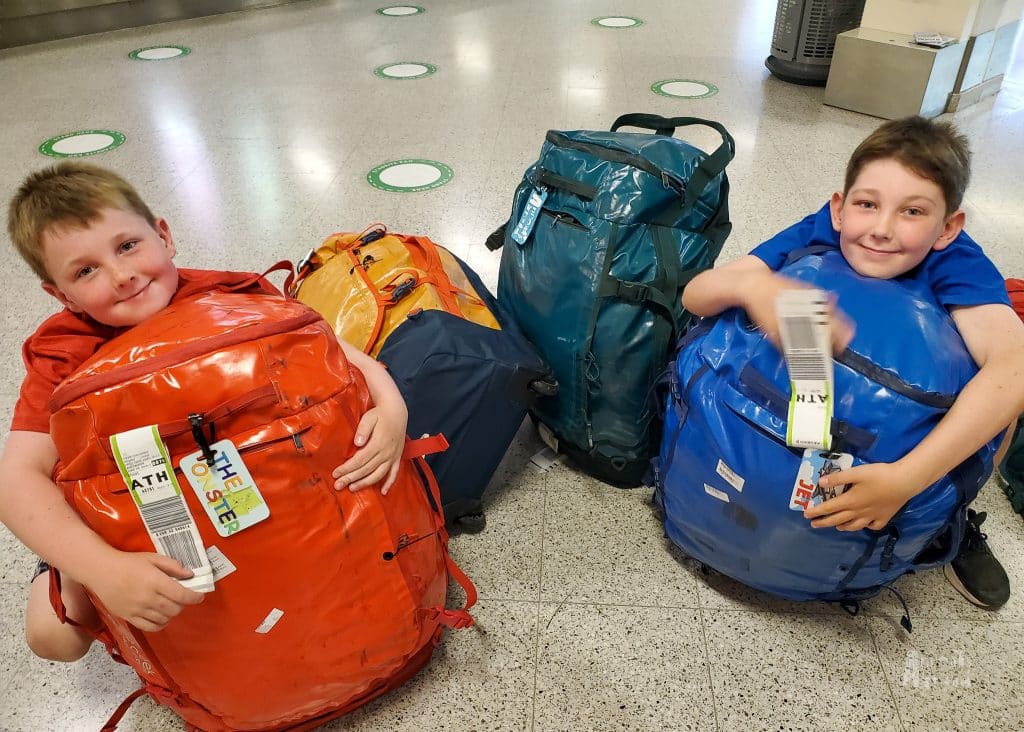
What clothing did you pack?
We travelled during the winter months (May–July) and experienced a wide range of temperatures from chilly nights around -2°C to warm afternoons reaching 30°C. The key to packing for a camping safari is COMFORT and LAYERS!
Here’s a basic breakdown of what we packed:
• 2–3 pairs of lightweight, quick-dry pants
• 1 pair of warmer pants – jeans or joggers (2 for kids)
• 2 long-sleeve dry-fit shirts (great for sun and mosquito protection)
• 2 pairs of shorts
• 3–4 t-shirts
• 1 pair of thermals (top and bottoms)
• 6 pairs of socks
• 6 pairs of underwear
• Hoodie
• Raincoat
• 1 pair of PJS (2 for kids)
• Runners
• Sandals
• Bathing suit
• Tuque + mittens
• Sun hat
Tip: Avoid overpacking—laundry is possible, and you’ll appreciate having less to dig through every day.
What about Laundry?
None of the campgrounds had laundry machines for guests to use. We did laundry only when we had a stay planned for a few days, allowing us to wash in sinks and hang to dry.
Bring concentrated laundry detergent sheets! Liquid detergent gets messy fast. We used Tru Earth Detergent Sheets, which are lightweight, compact, and mess-free.
Tip: Pack clothes that dry quickly, think dry-fit and workout fabrics. And bring extra socks and underwear so you’re not constantly washing.
Are there laundry services available?
Some campgrounds offered pricey laundry services, charging per item. We did use the laundry service once in Zambia (about halfway through the trip) to give everything a proper wash and refresh.
Was there anything else you packed?
A few bonus items that came in handy:
• Swiss Army knife
• A deck of cards and travel games
• Activity books for the kids
• Binoculars
• e-readers or tablets
• Headlamps
• Microfiber towels
• First-Aid/Medical Kit
• LifeStraw water bottles
Activities & Adventures
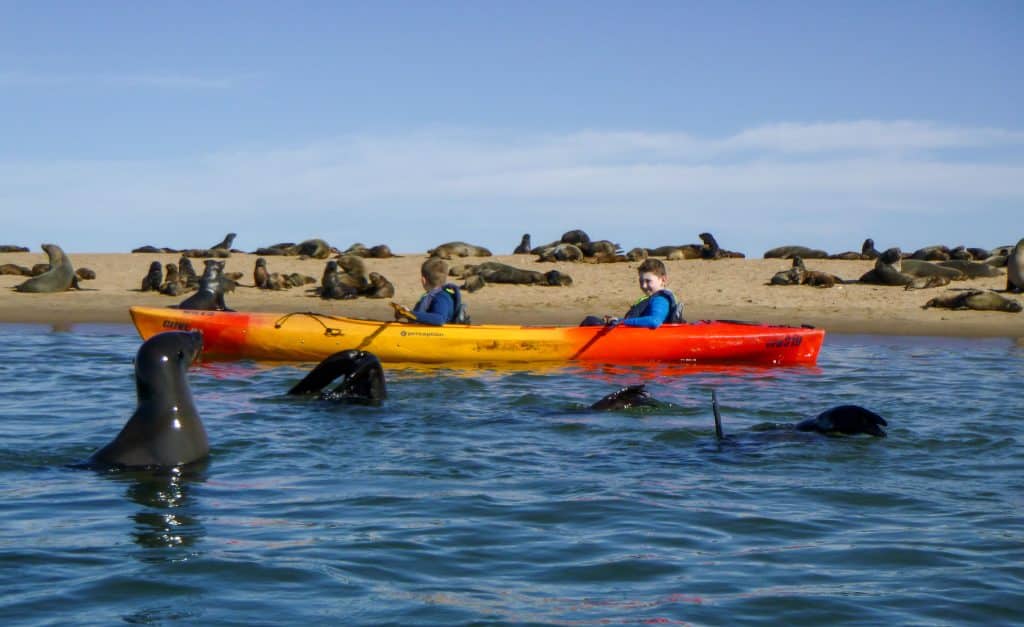
Besides the safari drives, what else did you do?
We discovered a range of adventures beyond the traditional game drives! Some of our favourite family-friendly activities included:
• Visiting Fish River Canyon, the largest canyon in Africa, for incredible views and hiking experiences.
• Exploring the vibrant orange dunes of Sossusvlei in Namibia’s iconic desert landscape.
• Driving along the haunting, windswept Skeleton Coast, where shipwrecks litter the shoreline like ghosts from the past.
• One of our most memorable days: Kayaking with Cape fur seals in Walvis Bay—an unforgettable, up-close encounter with playful wildlife!
Is it worth going on guided safari tours or self-driving?
Both options have their advantages, and we tried both. Here’s our take:
Self-driving safaris allowed us to explore at our own pace and personalize the experience. We could:
• Leave and return when we wanted
• Stay longer at a sighting if desired
• Focus on the animals we were most excited to see
• Spend less (just the park entrance fee)
This was a great fit for travelling with kids and gave us a sense of adventure. However, self-drivers must exit the park before sunset and can’t enter until after sunrise.
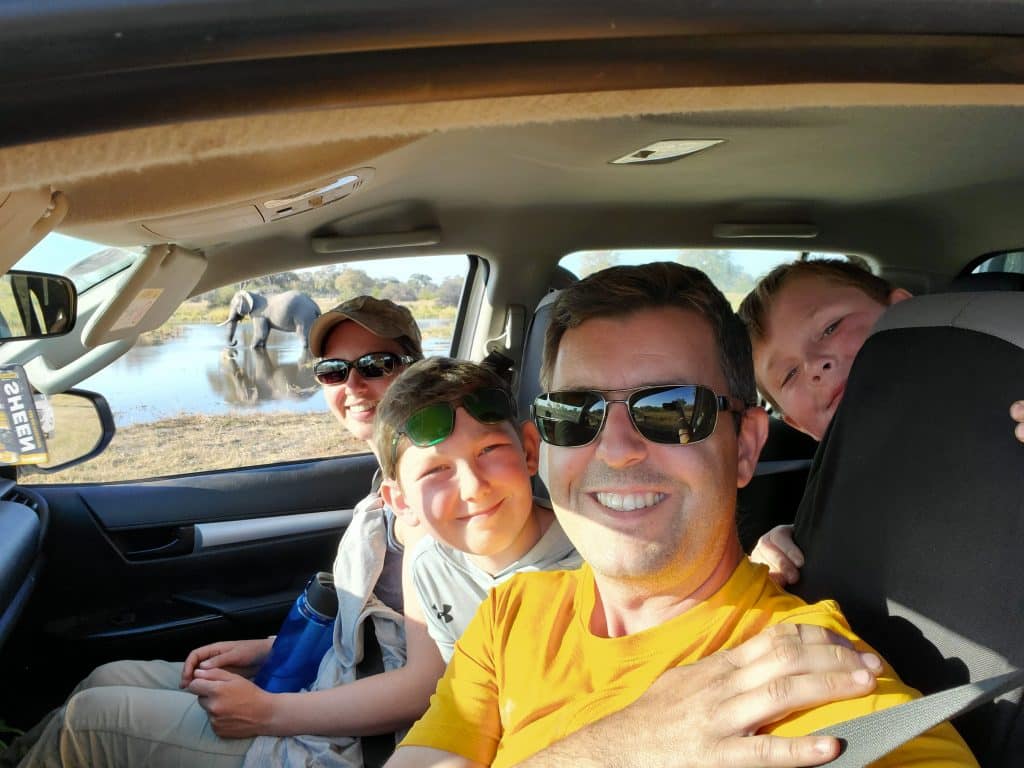
Guided safari tours offer a very different experience. The benefits include:
• Access to early morning and late evening game drives (outside regular self-drive hours)
• Knowledgeable guides and expert trackers
• Communication between guides using radios (which helps spot animals)
• Better understanding of the animals, plants, and park dynamics
• Options like night drives and private tours in some parks
On the downside, guided tours tend to be:
• More expensive
• Stuck to a set schedule
• Sometimes noisy (we’ve been on drives where other guests talked loudly, which reduced our chances of spotting wildlife)
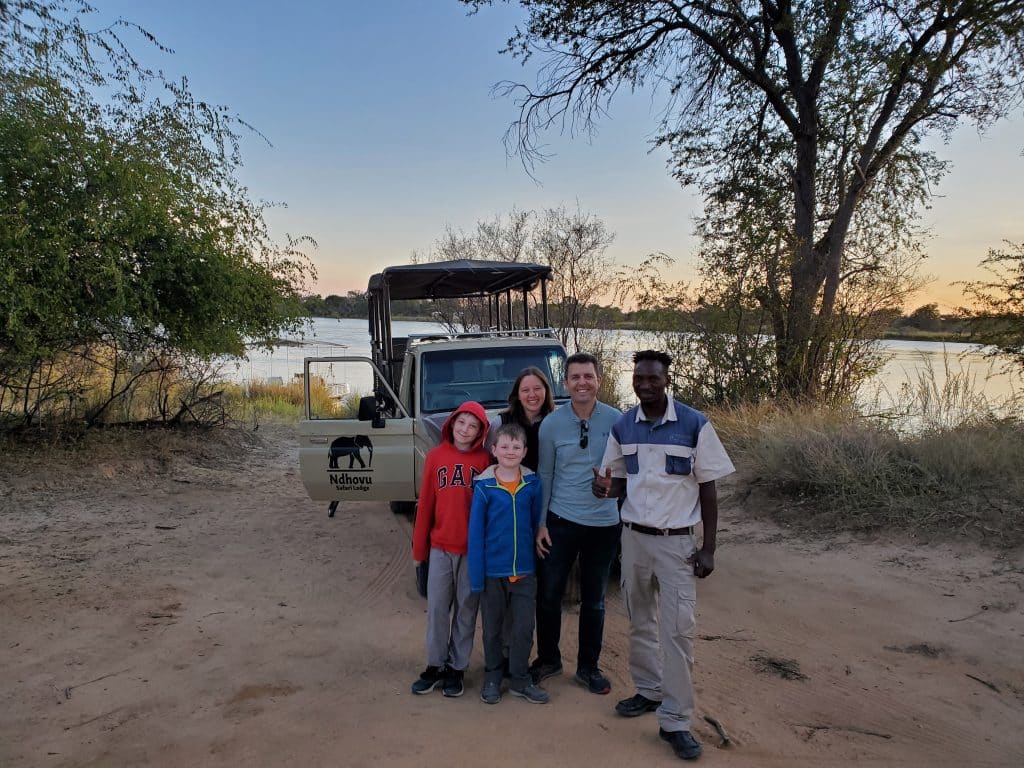
Our advice?
We preferred self-driving overall—it worked better with kids and gave us more flexibility. That said, we recommend doing at least one guided tour for the experience, especially in parks where night drives are possible or areas you’re less familiar with. If you’re watching your budget, Namibia and Zambia offer more affordable tour options than Botswana.
Curious how to prepare kids for a safari and keep them entertained between animal sightings? Learn More: Safari Tips for Kids
Would we do it again? Absolutely.
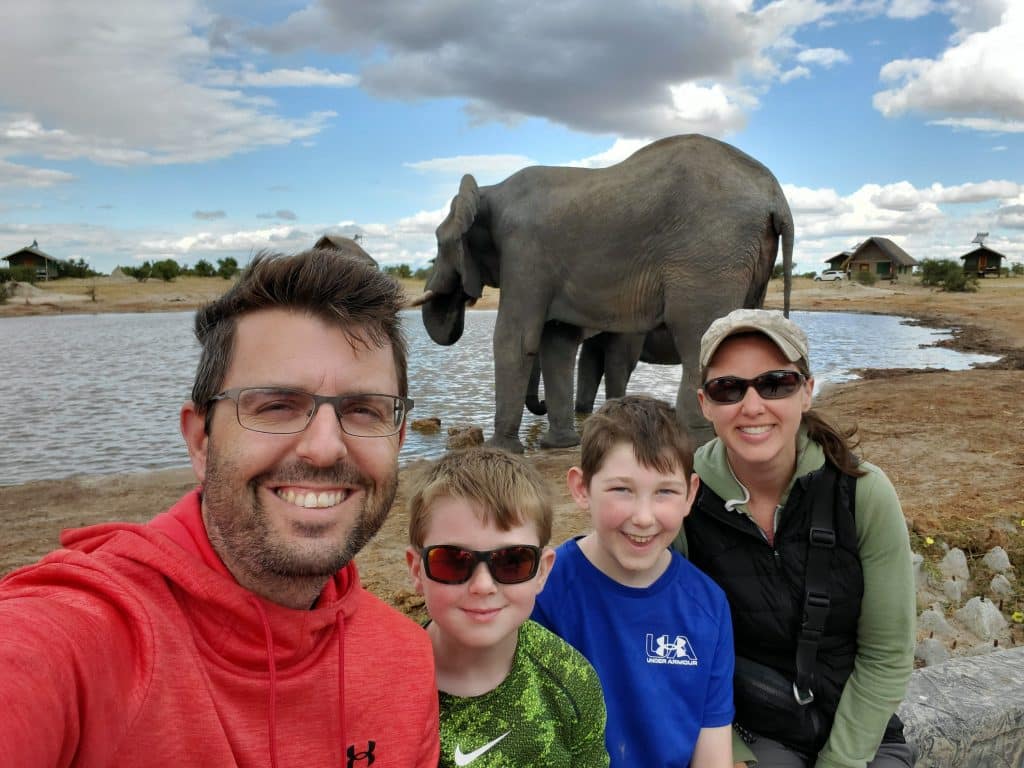
Our self-drive camping safari across Southern Africa was the adventure of a lifetime—full of wild encounters, stunning landscapes, and meaningful family moments. It wasn’t always easy, but it was always worth it. We learned so much along the way and would return in a heartbeat. If you’re considering this type of trip, we hope this guide helps you plan with confidence and inspires you to take the leap. The wild roads await.
Ready to Start Planning Your Safari Adventure?
Check out these related posts to help plan your trip:
- 51-Day Africa Safari – Part 1: South Africa & Namibia’s Coast
- 51-Day Africa Safari – Part 2: Namibia’s Etosha & Caprivi Strip
- 51-Day Africa Safari – Part 3: Victoria Falls & Botswana
- Our Best and Worst Day on Safari
- Camping Safari in Africa: Know Before You Go
- Camping Across Southern Africa: A Rundown of our Safari Campsites
- Navigating Border Crossings in Southern Africa
- Safari with Kids: Tips from the Road
- Etosha NP with Kids: A Family Safari to Remember
- Exploring the Caprivi Strip with Kids
- Okonjima Family Safari: Where the Wild Things Wait
- The Smoke that Thunders: A Trip to Victoria Falls
- Into the Wild: Chobe NP with Kids
- Sunset Cruise on the Chobe River: A Photo Journey
- Living Giants: A Photo Journey Through Nxai Pan National Park
